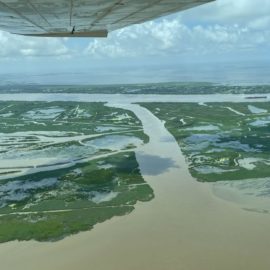
Neptune Pass is where the Mississippi runs so it is both used and makes land.
It’s the latest chapter in the story of Louisiana’s ever-shifting delta.A widening break in the Mississippi River bank far south of New Orleans is prompting the Army Corps of Engineers to move ahead with a temporary fix involving nearly 60,000 tons of stone. The stone will form a blanket to stabilize a section of the pass, located in Plaquemines Parish, and prevent further widening. The emergency action will address concerns over shipping along the river, a major worry considering the waterway’s international importance for moving goods. But longer-term questions remain over how to deal with Neptune Pass, and a plan is being studied to close it, though not completely. It is not simply a question of navigation. The future of the pass is also linked to questions over how to restore Louisiana’s disappearing coast. Because it is essentially acting as a large river diversion and building land in the bay it flows into, coastal advocates want to see it remain open as much as possible without harming shipping. “It’s very much an example of how a river delta can grow,” said Alex Kolker, a scientist with the Louisiana Universities Marine Consortium who has closely studied Neptune Pass and its effects.
nola.com
The pass is doing what the Mississippi has done through the ages, shift course.
The pass is a reminder of the river’s constant shifts over time, a process interrupted by the modern-day construction of levees to hold it in place and prevent catastrophic flooding. Breaks in the river’s banks, known as crevasses, in its lower reaches are not uncommon, and they don’t always require action from the Corps of Engineers, particularly if shipping is not affected. Located on the east bank across the river from Buras, Neptune Pass has widened from a narrow channel to a full-blown waterway of more than 800 feet wide. Recent measurements show it capturing about 15% of the river’s flow. That has affected shipping by causing a build-up of sediment in the area as well as a suction effect created by the pass, according to the Corps’ emergency action notification. Corps spokesman Ricky Boyett said the reduced flow of the river due to the size of the pass leads to sediment dropping out earlier than it usually would in the main channel. All of that leads to a shallower river channel, causing problems for vessels. “It’s had an impact on navigation,” Boyett said. “We’ve had to dredge in areas we’ve never had to dredge before.”
The stone will for a blanket.
The emergency plan involves using around 58,000 tons of stone to build a stabilizing blanket along the downriver bank of Neptune Pass where it meets the river to keep it from widening further. A public comment period on the plan ends Friday, with the aim to start the project in May and have it complete by June. But in this case, a problem has also come with an opportunity, coastal scientists note. The pass is diverting river sediment into nearby Quarantine Bay, part of Breton Sound, where it is building new land in an area that has eroded like the rest of Louisiana’s coast. State officials and coastal advocates hope the longer-term fix for the problem can include a way to allow some amount of sediment to flow through, which could continue to restore land and improve habitat in that area while providing a living example of the possibilities of river diversions. Separately, the state is planning two man-made, large-scale diversions to restore coastal land in the months and years ahead on the west and east banks of the river. Those projects are known as the Mid-Barataria and Mid-Breton sediment diversions. Both are upriver from Neptune and would be significantly smaller in size. The Corps’ long-term plan being studied involves building a rock closure for the pass, though without shutting it off completely, Boyett said. That could mean putting in place a control structure to allow small boats and sediment to continue to make it through. “The concept is to return it to its flow rate of 2019,” Boyett said, after which a large amount of widening began.
The hope is to have a new updated EIS.
Boyett said the Corps hopes to have a new version of an environmental study for the long-term plan out in late summer for public comment. He said it will take into account the land-building potential while also looking at whether the sediment moving into the bay is coming from the river or simply being transported from the widening banks of Neptune Pass. Kolker and a team of scientists have conducted research that suggests about a third of the sediment in Quarantine Bay is coming from the river itself. Alisha Renfro, a coastal scientist with the National Wildlife Federation, said there are hopes that a balance can be found between allowing for navigation while using the river’s land-building potential. “What should the water control structure look like?” she said. “How much should it reduce flow to get you the benefits to navigation that you need, but also keep as much flow as possible to continue building out this delta that is likely going to emerge here pretty soon?”
You can’t keep the Mississippi chained!


